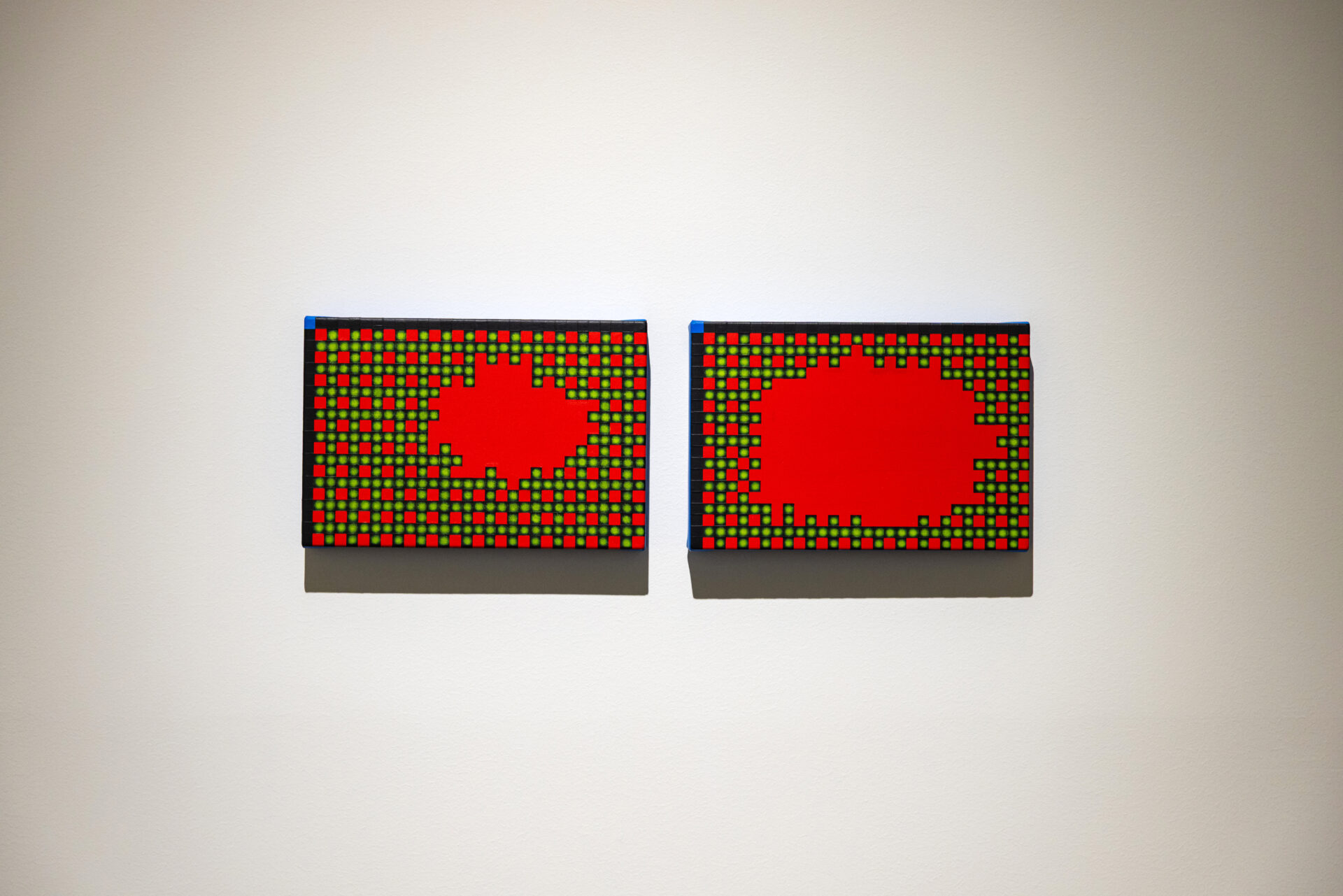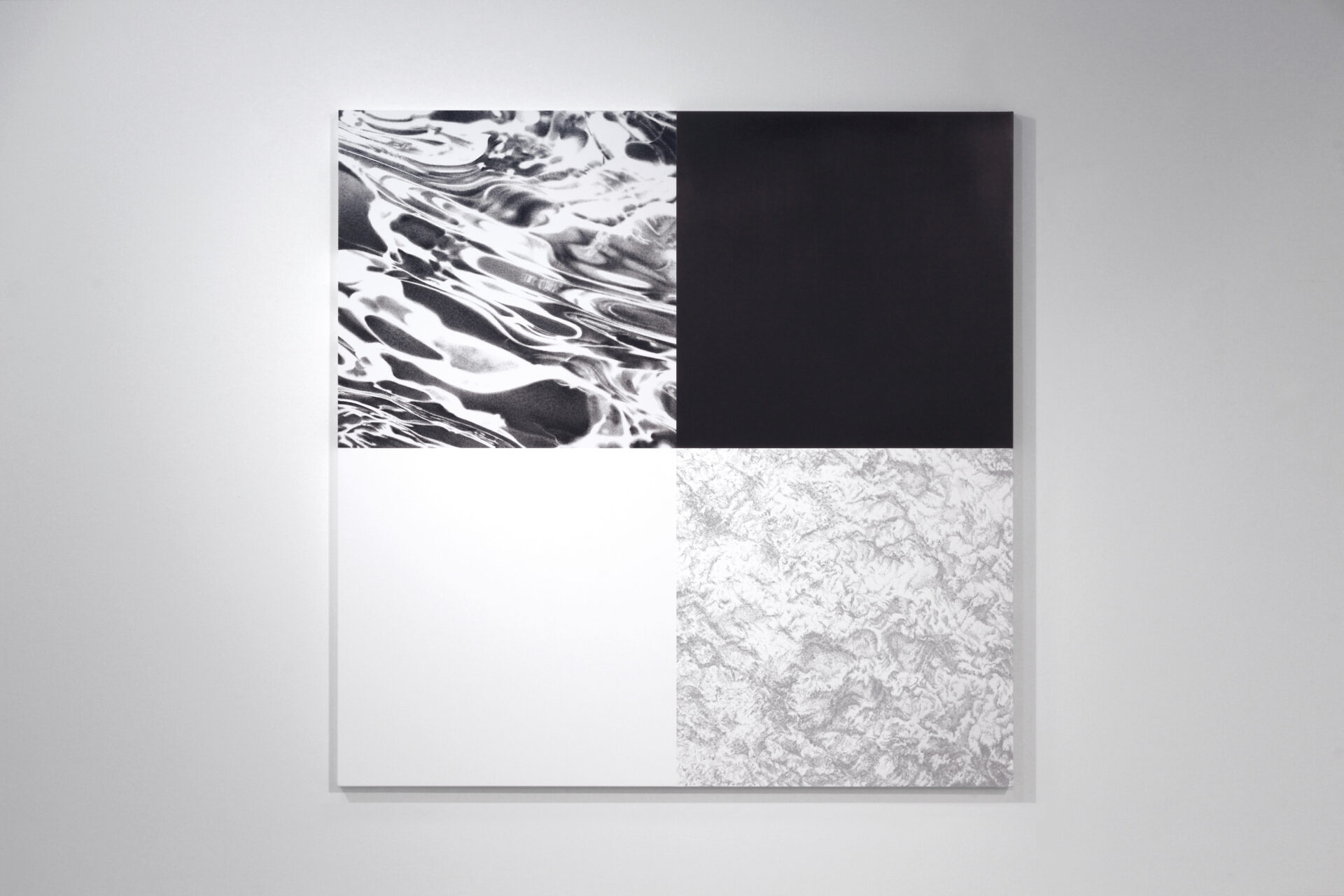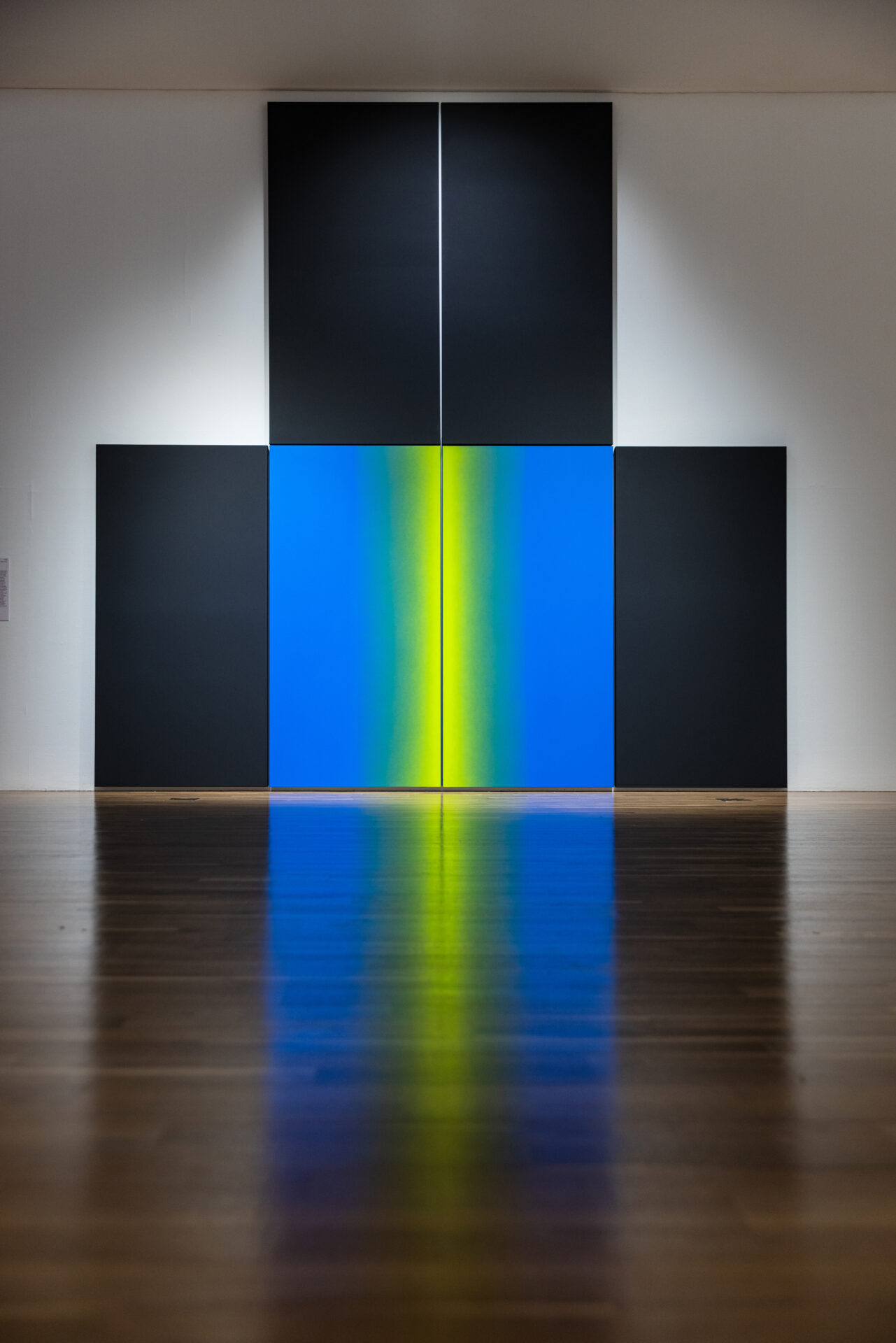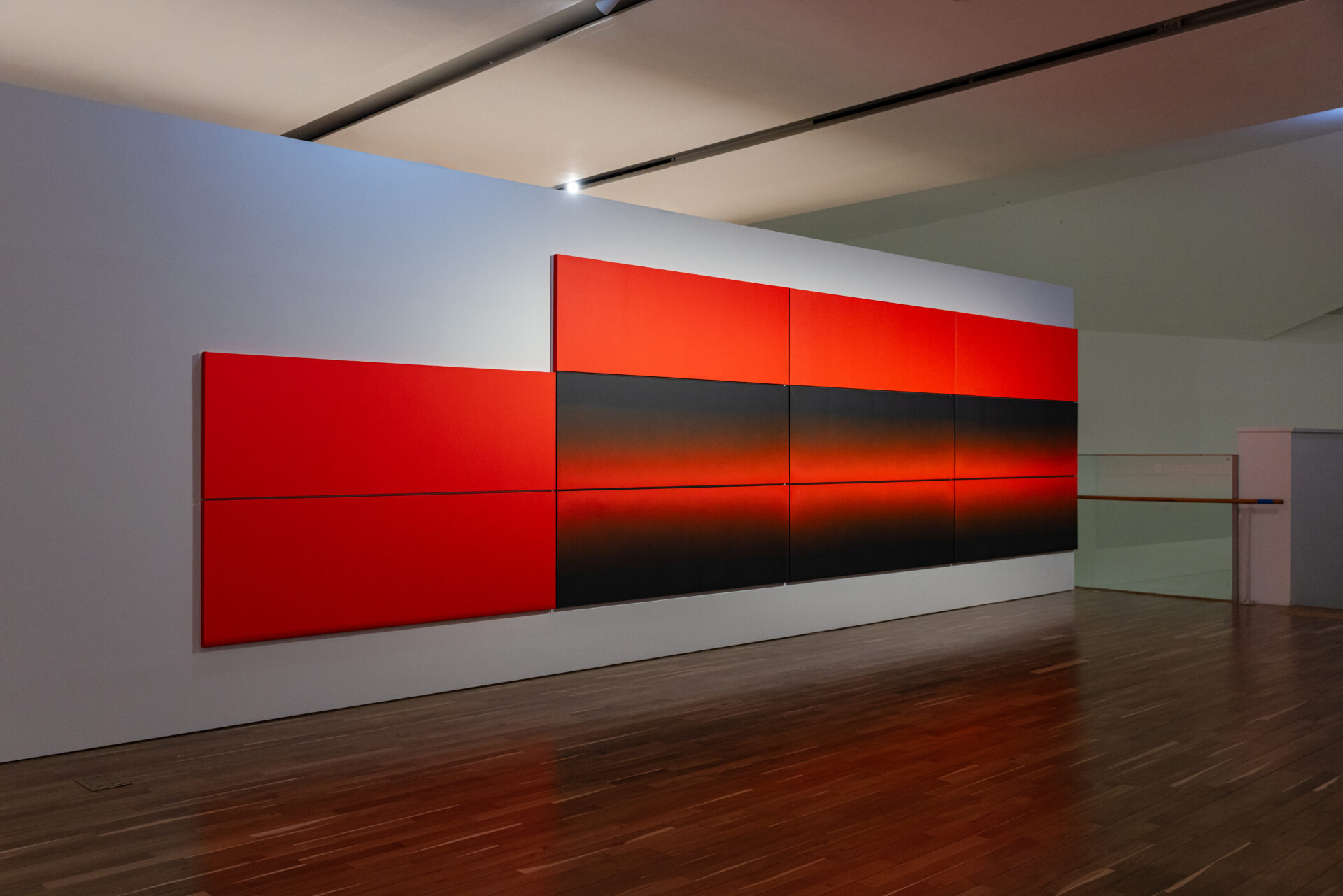〈시야〉 중앙에 구멍으로 유추되는 형상이 있다. 형상과 그 주변으로 복잡다단하게 펼쳐진 색들은, 맨 좌측과 윗면에 칠해진 얇은 띠의 두 검은 면이 교차하며 만들어낸 행렬값이다. 이 색들과 형상이 어디에서 왔는지 알 수 없으나, 이 중 싱크홀처럼 움푹 파인 듯해 보이는 붉은 면이 눈을 사로잡는다. 잘게 쪼개진 다른 면들과 달리 비워진 붉은 면은 구멍의 모습으로 우리의 시선을 안쪽으로 끌어들이는데, 이내 붉은 면이 튀어나오며 우리의 응시를 밀어낸다. 아직 그리지 못한 배경 혹은 누락된 공백으로 보였던 붉은 형상이 돌출하면서 우리의 눈은 혼란을 맞이한다. 작가의 표현처럼 자연스럽게 뻗어가던 시선의 화살표가 색이 지닌 움직임을 통해 반사되고 우리의 눈으로 다시 돌아온다. 이러한 시선의 반전을 통해 박아람은 그림이 지닌 무한한 움직임을 암시한다.
〈스톱워치〉는 박아람 작가 작업의 주요 작동 원리인 행렬과 그로 인한 움직임을 잘 보여주는 작품이다. 작가는 행렬 구조에서 x와 y축의 결괏값에 해당하는 지점을 다른 위치로의 이동으로 상정했다. 그리고 그 결괏값 지점과 대각선을 기준으로 대칭하는 좌측 상단의 지점을 멈춰있는 상태, 제자리로 지정했다. 〈스톱워치〉에서 제자리는 흐르는 물의 이미지로 밝은 부분부터 어두운 부분까지 변화가 큰 농도를 지녀 일렁이는 움직임을 담는다. 검은색과 흰색만으로 그려낸 물의 이미지에서 추출된 색은 사선의 행과 열에 배치되고, 이 검은색과 흰색의 행렬은 돌의 표면처럼 보이는 결괏값을 도출한다. 돌의 색은 검은색과 흰색이 아닌 회색과 흰색으로 그려져 있다. 이러한 어긋남은 물과 돌 사이의 낙차를 유도하며 돌의 요소이자 원인인 회색의 행방을 추적하게 한다. 회색은 사라진 것이 아니라 우리의 눈에 보이지 않을 뿐 작가가 주창하듯이 우리의 마음으로 소환할 수 있다.
〈오토 드라이브 5〉는 2021년부터 진행해 온 〈오토〉 연작 중 〈씽씽〉을 다시 배열한 그림이다. 〈씽씽〉은 수평으로 색 면을 배치하여 마치 밤거리를 달리는 자동차의 헤드라이트를 장시간의 노출시간으로 촬영한 듯한 모습을 갖는다. 주행의 형상은 색이 움직이는 인상을 전하는데, 〈오토 드라이브 5〉는 〈씽씽〉의 수평적 감각과 다른 수직적 움직임을 품는다. 화면 중앙에 그라데이션은 어딘가로 통하는 문처럼 보이기도 하고, 빛이 땅과 하늘 사이의 공간을 가르는 듯한 느낌을 준다. 단순한 행렬의 구조로 구현되었지만 관계성을 알 수 없는 색의 배치와 움직임을 느끼게 하는 그라데이션의 효과로, 〈오토 드라이브 5〉는 관객으로 하여금 상상의 나래를 펼치게 한다. 그 상상은 빛보다 빠르게 움직이며, 우리의 눈을 지나친다.
〈활주〉는 약 7.9m의 긴 회화 작품으로 막힌 난간을 향해 뻗어나가는 그림이다. 박아람 작가가 스텐실 붓으로 수 없는 점을 찍어 완성한 이 그림은, 활주하는 비행체의 기류를 연상케 하고, 한 치의 양보 없이 속도를 내는 불길을 상상하게 하기도 한다. 박아람이 고안한 행렬의 질서에 따라 꿈틀대는 색의 좌표는 이처럼 시각적 상상이 더해져 동력과 시공을 만들어낸다. 빨간색의 행렬이 가져야 할 결괏값을 뒤엎는 검은색의 등장은 보이지 않지만, 존재할 다른 좌표를 지시하며 심상을 자극한다. 비록 작품의 지지체인 캔버스의 끝은 난간에서 멈춰있지만, 난간 너머로 나아가려는 움직임을 느낄 수 있는 것처럼 작가는 〈활주〉를 통해 외부의 제약에서 벗어난 우리의 상상, 즉 마음의 눈을 펼치길 바란다. 그리고 그것의 끝이 난간 맞은 편의 벽이나 1층 전시장 바닥이 아닌 전시장 공간을 유영하는 움직임으로 이어지길 기대한다.
At the center of Sight is a shape that suggests a hole. The intricate spread of colors surrounding and radiating from this shape originates from matrix values generated by the intersection of two thin black bands—one painted along the leftmost edge, the other along the top surface. While the origin of these colors and shapes remains unknown, a red surface, concave like a sinkhole, immediately catches the eye. Unlike the finely segmented sections around it, this hollow red area draws the viewer’s gaze inward—only to push it back out as the surface appears to protrude. What first seemed like an unfinished background or an omitted blank abruptly asserts itself, disorienting the eye. As the artist describes, the arrow of vision that once extended outward is reflected by the movement of color and redirected back to the viewer. Through this reversal of gaze, Rahm Parc evokes the infinite motion contained within painting.
Stopwatch is a work that clearly demonstrates the core operating principle of Rahm Parc’s practice: the matrix structure and its resulting movement. In this work, the artist conceptualizes the intersection points of the x- and y-axes—where result values are generated—as moments of transition, shifting to new positions. In contrast, the point in the upper-left, which is symmetrical to the result point across the diagonal, is designated as a fixed position—a site of stillness. In Stopwatch, this still point takes the form of flowing water, rendered in black and white, whose dramatic tonal variations—from light to dark—evoke a rippling sense of motion. Colors extracted from this water image are distributed across diagonal rows and columns, forming a black-and-white matrix that produces result values resembling the surfaces of stone. Interestingly, the stone is not painted in black and white, but in gray and white. This subtle disjunction introduces a perceptual gap between water and stone, prompting viewers to trace the whereabouts of gray—both the element and the origin of the stone. As the artist suggests, gray has not disappeared; it merely eludes the eye, waiting to be summoned through the mind.
AUTO Drive 5 is a reconfiguration of another painting by Rahm Parc titled Seeing Seeing, part of the ongoing AUTO series the artist has been developing since 2021. In Seeing Seeing, horizontal bands of color evoke the long-exposure image of headlights streaming across a nighttime street. While that work conveys a sense of motion through a horizontal composition, AUTO Drive 5 introduces a contrasting vertical dynamic. The gradient at the center of the canvas appears like a door leading somewhere, or as if a shaft of light were dividing the space between earth and sky. Though composed within a simple matrix structure, the unknowable relationships between the colors and the shifting gradients invite the viewer into a realm of imagined movement. Here, imagination races faster than light—gliding past our eyes before we can even register what has occurred.
Runway is a painting measuring approximately 7.9 meters in length, extending toward a blocked railing as if propelled by unseen force. Created through countless dots applied with a stencil brush, it evokes the turbulent airflow trailing a taxiing aircraft—or an uncompromising flame surging forward at full speed. The coordinates of color, undulating according to the matrix logic Rahm Parc devised, generate momentum and spatiotemporal dimensions when activated by the viewer’s visual imagination. The appearance of black, which overrides the expected results of a red matrix, points to the existence of unseen coordinates, stirring the mind’s eye. Although the canvas, as a physical support, stops at the railing, the work evokes propulsion beyond that boundary. With Runway, viewers are invited to expand their inner vision, freed from external constraints—not toward the wall across or the floor below, but into a movement that drifts and circulates through the exhibition space.



